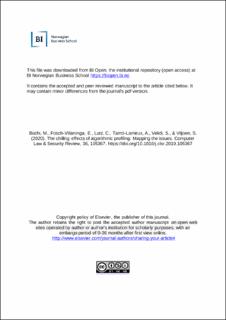| dc.contributor.author | Büchi, Moritz | |
| dc.contributor.author | Fosch Villaronga, Eduard | |
| dc.contributor.author | Lutz, Christoph | |
| dc.contributor.author | Tamò-Larrieux, Aurelia | |
| dc.contributor.author | Velidi, Shruthi | |
| dc.contributor.author | Viljoen, Salome | |
| dc.date.accessioned | 2021-02-01T13:41:18Z | |
| dc.date.available | 2021-02-01T13:41:18Z | |
| dc.date.created | 2019-10-30T10:23:18Z | |
| dc.date.issued | 2019 | |
| dc.identifier.citation | Computer Law and Security Review. 2019, 36 (April) | en_US |
| dc.identifier.issn | 0267-3649 | |
| dc.identifier.uri | https://hdl.handle.net/11250/2725608 | |
| dc.description.abstract | In this article, we provide an overview of the literature on chilling effects and corporate profiling, while also connecting the two topics. We start by explaining how profiling, in an increasingly data-rich environment, creates substantial power asymmetries between users and platforms (and corporations more broadly). Inferences and the increasingly automated nature of decision-making, both based on user data, are essential aspects of profiling. We then connect chilling effects theory and the relevant empirical findings to corporate profiling. In this article, we first stress the relationship and similarities between profiling and surveillance. Second, we describe chilling effects as a result of state and peer surveillance, specifically. We then show the interrelatedness of corporate and state profiling, and finally spotlight the customization of behavior and behavioral manipulation as particularly significant issues in this discourse. This is complemented with an exploration of the legal foundations of profiling through an analysis of European and US data protection law. We find that while Europe has a clear regulatory framework in place for profiling, the US primarily relies on a patchwork of sector-specific or state laws. Further, there is an attempt to regulate differential impacts of profiling via anti-discrimination statutes, yet few policies focus on combating generalized harms of profiling, such as chilling effects. Finally, we devise four concise propositions to guide future research on the connection between corporate profiling and chilling effects. | en_US |
| dc.language.iso | eng | en_US |
| dc.publisher | Elsevier | en_US |
| dc.rights | Attribution-NonCommercial-NoDerivatives 4.0 Internasjonal | * |
| dc.rights.uri | http://creativecommons.org/licenses/by-nc-nd/4.0/deed.no | * |
| dc.title | The Chilling Effects of Algorithmic Profiling: Mapping the Issues | en_US |
| dc.type | Journal article | en_US |
| dc.type | Peer reviewed | en_US |
| dc.description.version | acceptedVersion | en_US |
| dc.source.pagenumber | 15 | en_US |
| dc.source.volume | 36 | en_US |
| dc.source.journal | Computer Law and Security Review | en_US |
| dc.source.issue | April | en_US |
| dc.identifier.doi | 10.1016/j.clsr.2019.105367 | |
| dc.identifier.cristin | 1742033 | |
| dc.relation.project | Norges forskningsråd: 275347 | en_US |
| dc.source.articlenumber | 105367 | en_US |
| cristin.unitcode | 158,9,0,0 | |
| cristin.unitname | Institutt for kommunikasjon og kultur | |
| cristin.ispublished | true | |
| cristin.fulltext | postprint | |
| cristin.qualitycode | 1 | |

